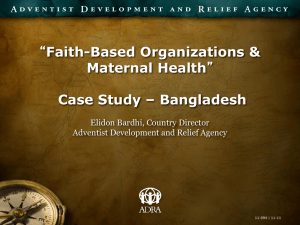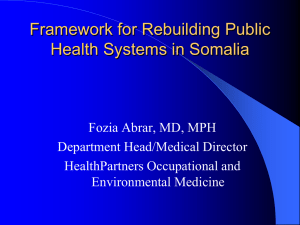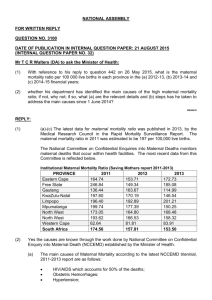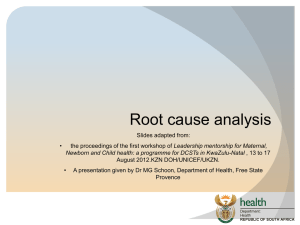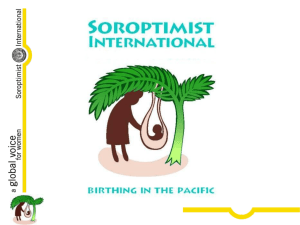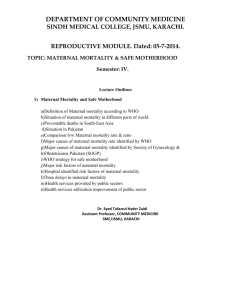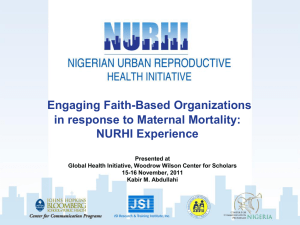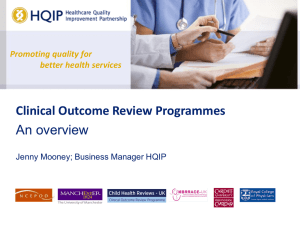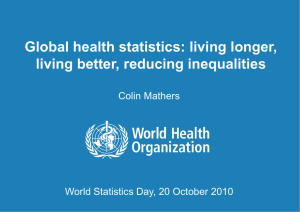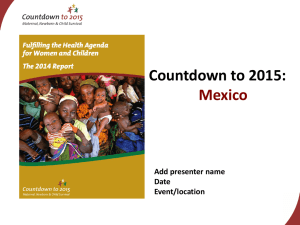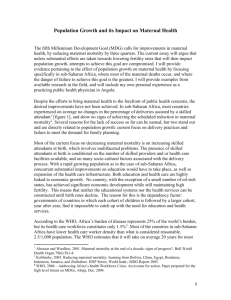Liberal Caucus presentation May 5, 2010, G8
advertisement
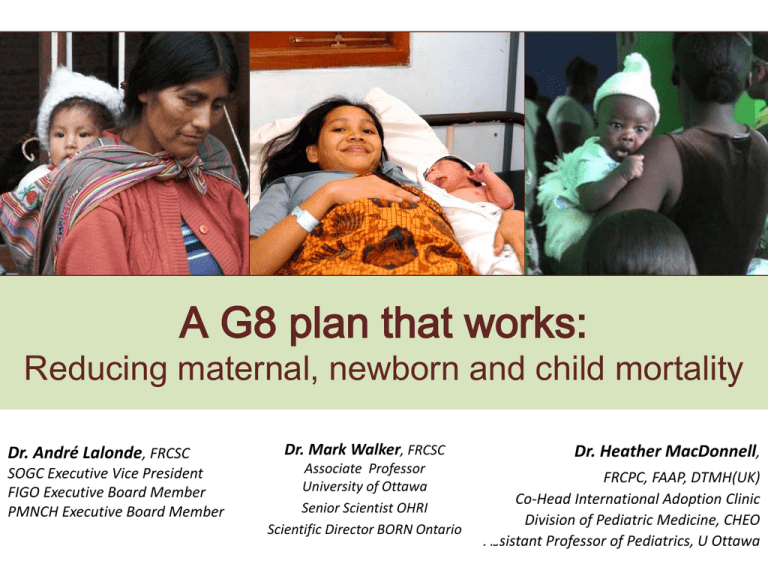
A G8 plan that works: Reducing maternal, newborn and child mortality Dr. André Lalonde, FRCSC SOGC Executive Vice President FIGO Executive Board Member PMNCH Executive Board Member Dr. Mark Walker, FRCSC Associate Professor University of Ottawa Senior Scientist OHRI Scientific Director BORN Ontario Dr. Heather MacDonnell, FRCPC, FAAP, DTMH(UK) Co-Head International Adoption Clinic Division of Pediatric Medicine, CHEO Assistant Professor of Pediatrics, U Ottawa Canada to host the 2010 G8 Summit This year, Canada is presented with an important opportunity to reaffirm itself as a global humanitarian leader, as we welcome world leaders to the 2010 G8 and G20 Summits. G8 to focus on Maternal and Child Health Prime Minister Harper’s announcement is a step in the right direction. But what exactly is included in the mother and child initiative? And will promises be met? Millennium Development Goals Millennium Development Goals 4. Reduce Child Mortality • Target: – Reduce by 2/3, between 1990 and 2015, the mortality rate of children under 5 • Indicators: – Under-five mortality rate – Infant mortality rate – Proportion of one-year-old children immunized against measles Millennium Development Goals 5. Improve Maternal Health • Target 5.A: – Reduce by 3/4, between 1990 and 2015, the maternal mortality ratio • Indicators: – Maternal mortality ratio – Proportion of birth attended by skilled health personnel • Target 5.B: Achieve, by 2015, universal access to reproductive health • Indicators: Contraceptive prevalence rate Adolescent birth rate Antenatal care coverage Unmet need for family planning Global Situation • • • • • • • • • • • 180-210 million pregnancies every year 80 million unwanted pregnancies 50 million induced abortions 20 million unsafe abortions 68,000 deaths from unsafe abortion 20 million women suffer from maternal morbidity Estimated 536,000 maternal deaths 3 million babies are born dead Almost 10 million children under 5 die Of which 3 million newborns die within the first week of life 500,000 infants are infected with HIV Progress toward MDG 4: 15 countries 'on track' 25 countries 'no progress' No progress Insufficien t On track Source: Progress for children. A world fit for children. Statistical tables on MDG4. Available at http://www.unicef.org/progressforchildren/2007n6/index_41854.htm Countries with increasing U5MR Progress toward MDG 5 • 12 of 13 countries with highest Maternal Mortality Ratios are in sub-Saharan Africa • Pattern of contextual factors differs from that of MDG4. High HIV prevalence (>5%, 1/13) Conflict (8/13) Coverage failures across the continuum of care For some interventions: • Family planning • Exclusive breastfeeding • Clinical care for newborn and child illnesses In some countries: • Wide gaps in coverage across countries Coverage estimates for interventions across the continuum of care in the 68 priority countries (2000-2006). Vertical bars indicate the range in coverage across countries. Key strategies to reduce maternal mortality Access to contraceptives, to avoid unintended pregnancies Access to skilled care at the time of birth Timely access to emergency obstetric care in the event of complications Skilled attendance at birth saves mothers and babies Skilled attendance at childbirth is the most effective intervention World Health Organization April 05 The Global Consensus for Maternal, Newborn and Child Health: 1. Political leadership and community engagement and mobilization 2. Delivering high quality services 3. Removing financial, social, and cultural barriers to access 4. Ensuring skilled and motivated health workers 5. Accountability at all levels for credible results Lives that can be saved and investment required: Global Child Mortality: Key Messages Globally, 1 in 7 children die before the age of 5 = 9.2 million children in 2007 = 15 filled school buses crashing per hour Most under-5 deaths are preventable • pneumonia, newborn causes, diarrhea, malaria, measles Simple strategies prevent deaths and are not necessarily expensive! Under 5 (Child) Mortality Reduction Rates 244 UnderFive Mortality Rate 206 188 Sub-Saharan Africa 171 123 129 (per 1000 live births) South Asia 122 92 58 54 East Asia 36 31 Latin America 1970 2004 UNICEF State of the World’s Children 1990 2015 62 42.6 19.1 17.8 MDG-4 Goals Child Mortality Rate /1000 live births Infant Mortality Rate /1000 live births Stillbirth Rate /1000 total births UNICEF State of the World’s Children 6 130 5 84 3 32 Preventable Conditions Cause Most Child Deaths Infection 36% Acute Respiratory Illnesses, 17% Prematurity 27% Asphyxia 23% } Neonatal deaths, 37% Malnutrition 55% Malaria, 7% WHO data Other, 23% Diarrhea, 16% What can be done to save the children? Postpartum • • • • . Clean cord care Skin to skin with mother (kangaroo care) Antibiotics for suspected sepsis Early breastfeeding, exclusive x 6 months What can be done to save the children? Early Infancy and Beyond • Routine immunizations • Regular growth measurements • Health education to mothers – Hygiene, clean water, sanitation • Antibiotics for pneumonia • Iron, Zinc, Vitamin A supplementation . • Insecticide treated bed nets Save a child’s life for a pittance Estimated cost of interventions: Insecticide-treated bed net Full WHO EPI immunizations (Africa) Oral rehydration solution (ORS) Total cost $887 per life saved Save 800,000 African newborns at $1.39 per person per year $6 $14 < $1 Recommendations • Focus on essential interventions that will prevent or reduce maternal, newborn and child mortality and morbidity • Increase capacity with training of skilled birth attendants and health care providers at all levels • Improve and strengthen physical infrastructure of health care facilities and supply of commodities • Embed surveillance into programs to drive process with measureable outcomes and send feedback on progress made back to the community 3+3+3 By focusing efforts on the 3 main causes of death, we can make real progress to improve the health of women, newborns and children Maternal Health -Post partum hemorrhage -Eclampsia -Dystocia Newborn Health -Infection -Prematurity -Asphyxia Child Health -Acute respiratory illness -Diarrhea -Malaria The way forward for Canada to lead in the area of Maternal and Child Health • Increased funding for maternal and child health programs • Focus on the main causes of mortality and morbidity • Capitalize on Canada’s expertise in the field of maternal and child health to strengthen programs and improve health outcomes • Use a rights-based approach • Ensure family planning • Upgrade the skills of health professionals, especially in the area of Emergency Obstetric Care • Ensure programs are directed at all levels of service delivery (local, regional, national) • Use the three delays model to influence program design and fund allocation • Allocate funding in a way that addresses gaps along the continuum of care Conclusion • Maternal survival and health is essential for the economic development of nations • Survival and health of the world’s newborns and children depends on their mothers • Parliamentarians need to play their part for Canada to assume a leadership role There is no better time to raise your voice for women and children worldwide
